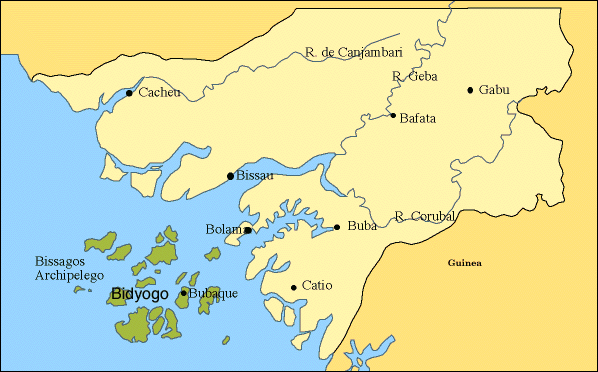

The Bijagós archipelago consists of 88 semitropical islands, only 23 of which are inhabited. Early settlement in the area that is now the nation of Guinea-Bissau started from the interior of Africa and moved westward, and it is believed that people arrived on the coast by 9000 B.C. Members of the broad Senegambian ethnic group who settled the islands became known as the Bijagós (Bissagos) people, a matriarchal and matrilineal society in which women choose their husbands and that is guided by female priests. Traditionally a hunter-gatherer society, they were famous for their almadias, large ocean-going canoes that could hold up to 70 people.


Picture of Samgambian ethnic group women
In 1446 the Portuguese captains Gil Eannes and Nuño Tristão landed the Bijago Islands of Guinea-Bissau to trade slaves, gold, ivory and pepper. In that year Portugal claimed the region as "Portuguese Guinea." The rivers of Guinea, governed by the Mali's tributary kingdom of Gabu, and the islands of Cape Verde and the Bijago Archipelagos were some of the first areas in Africa explored by the Portuguese. It was the strength of the kingdom of Gabu that kept the Portuguese from inhabiting the interior as they had done on the Cape Verde Islands.
Kingdom of Gabu
In the mid 13th century, Malian general Tiramakhan Traore, under King Sundiata, founded the semiautonomous tributary kingdom of Gabu (N'Gabu, Kaabu, Quebu). Traore brought Mali's soldiers to the Mandingo inhabited Cassamance region of today's southern Senegal (a region of historical significance to Guinea-Bissau) and to the northeastern portion of what is today Guinea-Bissau. The first king, said to be the grandson of Traore, named Mansa Sama Coli (Kelemankoto Baa Saane) appointed Mandingo leaders as administrators of the kingdom's three provinces; Pachana (Pathiana) at the headwaters of the Rio Geba, the main river in Guinea-Bissau, Jimara (Djimara) south of the headwaters of the the Gambia River; and Sama on the Cassamance. The capital city, Kansala, is in Guinea-Bissau on the northeastern border with Senegal. The artistic and wealthy kingdom of Gabu is noted for originating the West African harp call the Kora.
African Slave Trade
In 1630, an administrative office called the "captaincy-general of Portuguese Guinea" was formed to oversee governance of trade in the region. At that time several trading posts were established. The Portuguese exported large numbers of African slaves to the Western Hemisphere through Cape Verde Islands. Cacheu, in the northern part of present day Guinea-Bissau, became one of Portugal's slave trade centers. A small fort remains to this day.
 Portuguese slave fort
Portuguese slave fort
The slave trade declined in the 19th century, and Bissau, originally founded as a military and slave-trading center in 1765, grew to become the major commercial center.
Sources:
http://www.uiowa.edu/~africart/toc/countries/Guinea-Bissau.html
http://www.zyama.com/Iowa/Countres/Guinea-Bissau.htm
http://www.gambia.dk/forums/topic.asp?TOPIC_ID=10242
http://www.gambia.dk/forums/topic.asp?TOPIC_ID=9013
Comments (0)
You don't have permission to comment on this page.